See Also
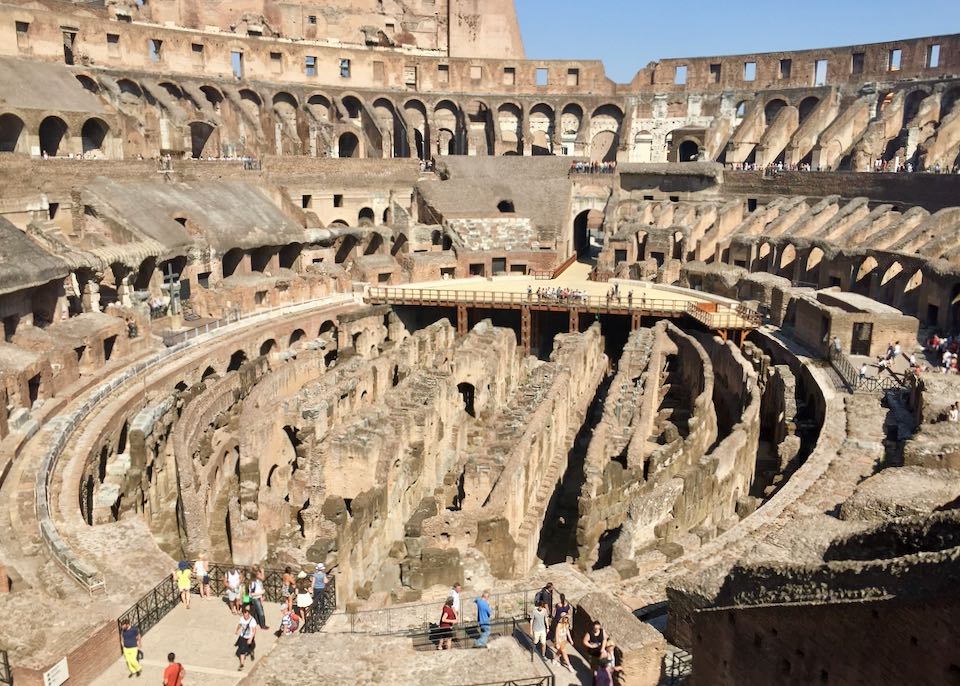
The VIP Colosseum Tour is highly recommended.
The 6 Best Tours in Rome
The Testaccio Food Tour that we did was excellent.
- 1. VIP Colosseum Tour – Excellent guided tour of Ancient Rome, Roman Forum, and Palatine Hill. Skip the line to enter all three sites. Relaxed and informative
- 2. Roman Neighborhoods: Walking Food Tour – Great tour of local shops and restaurants with plenty of tastings (we were stuffed by the end). A good amount of time is spent in Trastevere, my favorite Roman neighborhood. We also did a good food tour of Testaccio and an excellent pasta-making class in Trastevere.
- 3. Pristine Sistine Early Entrance Small Group Vatican Tour – The absolute best way to see the Sistine Chapel, Vatican Museums, and St. Peter’s Basilica. No crowds, just art and architecture.
- 4. Rome In A Day – Great tour of the highlights of Ancient Rome and the Vatican. If you want one tour that covers a bit of everything then this is it.
- 5. Gladiator School – Out kids loved this. They adjust the intensity and “training” based on your age. The end result is that all ages have a blast. Instructors are great. Book far in advance.
- 6. Bike Tour: Ancient Appian Way, Aqueducts, & Catacombs – Fun and easy tour through Rome countryside with knowledgeable guide. Mountain bikes or electric assist.
The 45 Best Things to Do in Rome
1. Colosseum
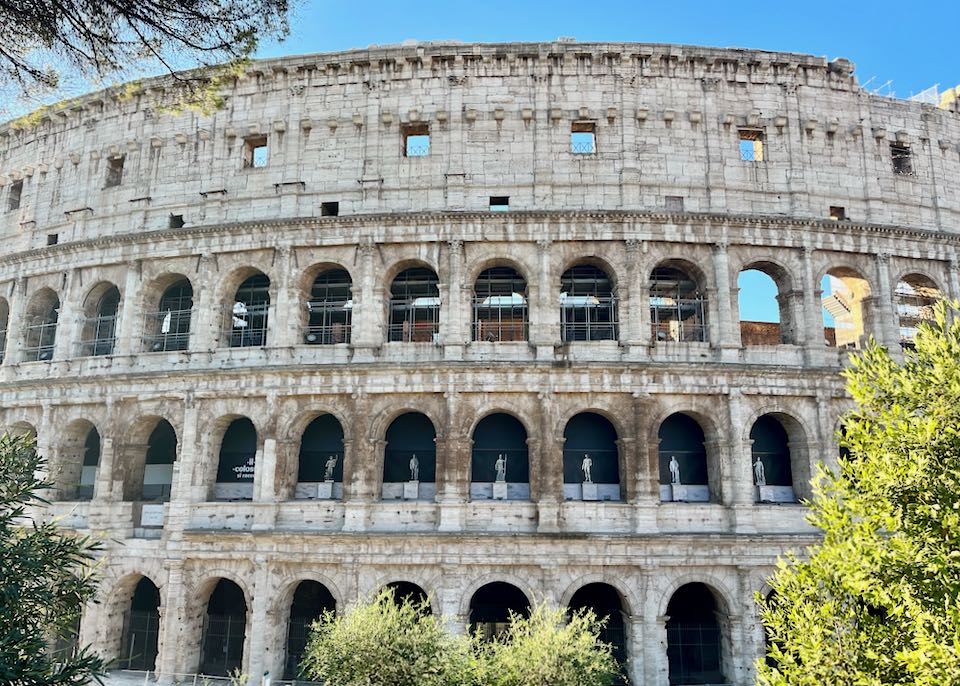
Rome’s iconic amphitheater is the most spectacular of the city’s great monuments. This was ancient Rome’s showpiece stadium, a vast 50,000-seater used to stage gladiatorial games and bloody shows featuring animal hunts and public executions. Originally known as the Flavian Amphitheater (the name Colosseum was coined in medieval times to refer to a colossal statue of Nero that stood nearby), it was built by the emperor Vespasian and inaugurated in AD 80. The design was a masterpiece of ancient engineering with numbered entrance arches and seating in three steeply stacked tiers. Overhead, a vast canvas awning provided shade for spectators, while down below the performers slugged it out on the sand-covered arena. Beneath the arena was a network of subterranean corridors known as the hypogeum, used to pen animals and as an underground entrance for gladiators from the nearby Ludus Magister (gladiator school). The hypogeum is viewable only via guided tour – book in advance when you buy your tickets. Crowds are still the norm at the Colosseum and you’ll almost certainly have to queue to get in. To cut waiting time, either book your ticket online or buy at Palatine (where queues are shorter) – tickets cover the Colosseum, Palatine and Roman Forum. The VIP Colosseum Tour with Roman Forum & Palatine Hill is highly recommended.
2. Roman Forum
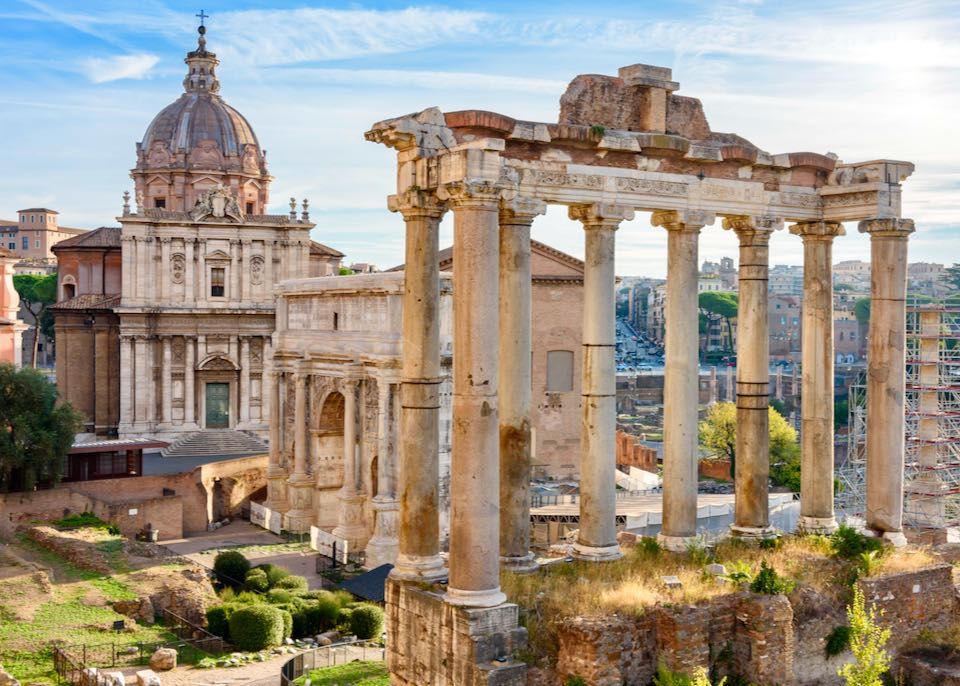
These sprawling ruins that extend from the Colosseum to the Capitoline Hill, the Roman Forum was ancient Rome’s showcase hub, a hectic precinct of grand temples, law courts, offices and noisy public squares. Few buildings have survived in great shape but it’s still a fascinating place to explore. Some of the best-preserved structures are in the north-western sector – this is where you’ll find the Curia, the original seat of the Roman Senate, and the Arch of Saptami’s Severus, one of Rome’s most imposing triumphal arches. Nearby, a series of columns survive from the Temple of Saturn, the Fort Knox of ancient Rome where the city’s gold and silver reserves were kept. Toward the Colosseum end of the Forum, the Temple of Caesar marks the spot where Julius Caesar was cremated after his murder in 44 BC. Further on, you’ll see the Casa delle Vestali, the house where the Vestal Virgins used to live, and the Arch of Titus, a stocky arch commemorating Titus’ successful suppression of a rebellion in Jerusalem. Note that the Roman Forum is covered by the same ticket as the Colosseum and Palatine Hill.
3. Palatine Hill

Just down the road from the Colosseum, the Palatine is Rome’s mythical birthplace – according to legend, Romulus founded the city here in 753 BC. Later, it was Rome’s smartest neighborhood, where wealthy patricians and celebrity generals lived in the shadow of the imperial palace – the word ‘palace’ is derived from the Latin name for the hill, palatium. Most of the ruins you see today are what’s left of the emperor Domitian’s sprawling 1st-century palace. Highlights to look out for include the emperor’s private stadium; a small museum of artifacts found onsite; the Casa di Augusto, the emperor’s private residence; and the Casa di Livia, home of Augustus’ wife. In the northeast corner, known as the Orti Farnesiani, you can enjoy amazing views from a viewing balcony overlooking the Roman Forum. Note that the Palatine is covered by the same ticket as the Colosseum and Roman Forum.
4. Capitoline Museums
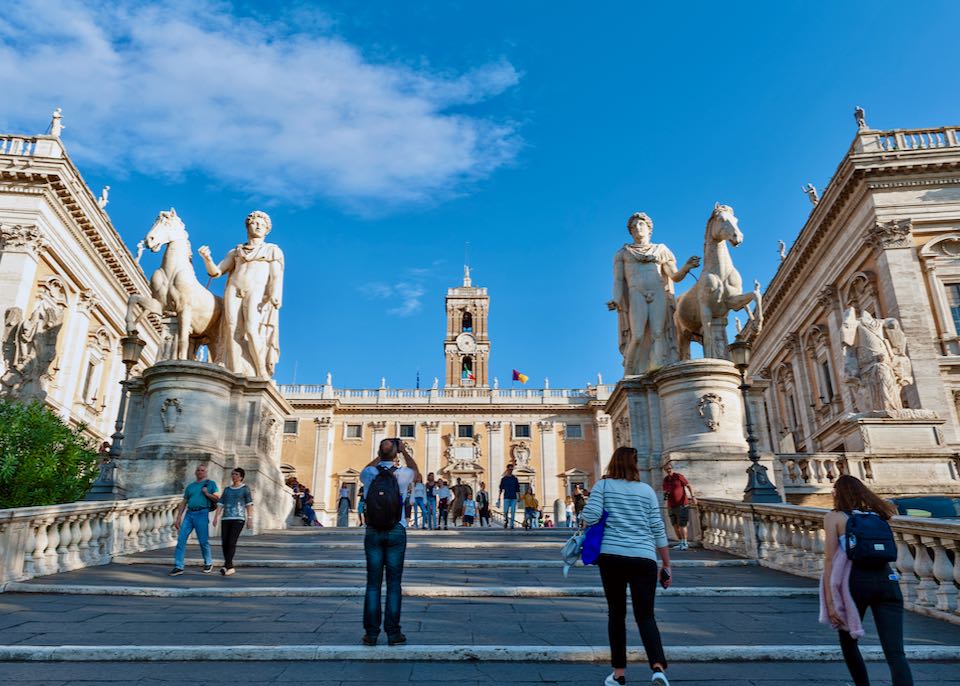
Founded in 1471, the Capitoline Museums are said to be the world’s oldest public museums. They are certainly among Rome’s best, showcasing a spectacular collection of classical sculpture and Old Master paintings. The museums are housed in two elegant palazzi on Piazza del Campidoglio, itself one of Rome’s most beautiful squares. (The third building on the piazza, Palazzo Senatorio, is Rome’s City Hall.) Museum visits start in Palazzo dei Conservatori, whose courtyard is littered with giant marble body parts – originally from a giant statue of Constantine in the Roman Forum. Upstairs, check out the famous Capitoline She-wolf, and a bust of Medusa by Gian Lorenzo Bernini. Continuing up, the second-floor picture gallery contains some magnificent Renaissance and baroque canvases by artists such as Caravaggio, Titian, and Rubens. From the palazzo, an underground passage leads to the museum’s Palazzo Nuovo and yet more fabulous sculptures – one of the finest pieces is the Capitoline Gaul, a harrowing depiction of a dying Gaul warrior.
5. Victor Emmanuel Monument
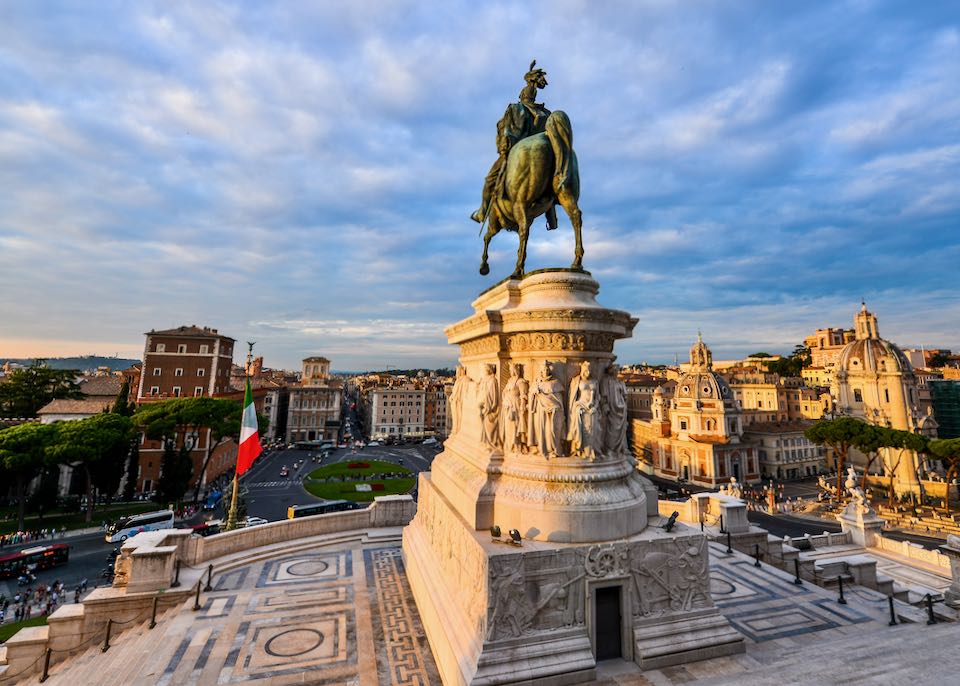
Looming massively over Piazza Venezia, this towering white monument dominates Rome’s skyline. But as dramatic as it is, it’s disliked by locals who write it off as a glorified viewing platform, saying it’s the only place in town where it can’t actually be seen from. Certainly, the views it offers are sensational, especially if you take the panoramic lift (€7/3.50) to the top. Known as Altare della Patria (Altar of the Fatherland) or Vittoriano, it was built at the end of the 19th century to celebrate Italian unification and to honor Italy’s first king, Victor Emanuel II, who’s immortalized in the giant equestrian statue. As well as climbing its huge terraces, you can also explore the monument’s cavernous interior. Visit the Tomb of the Unknown Soldier, and check for exhibitions: art at the Complesso del Vittoriano, and history at the Museo Centrale del Risorgimento.
6. Trajan’s Markets
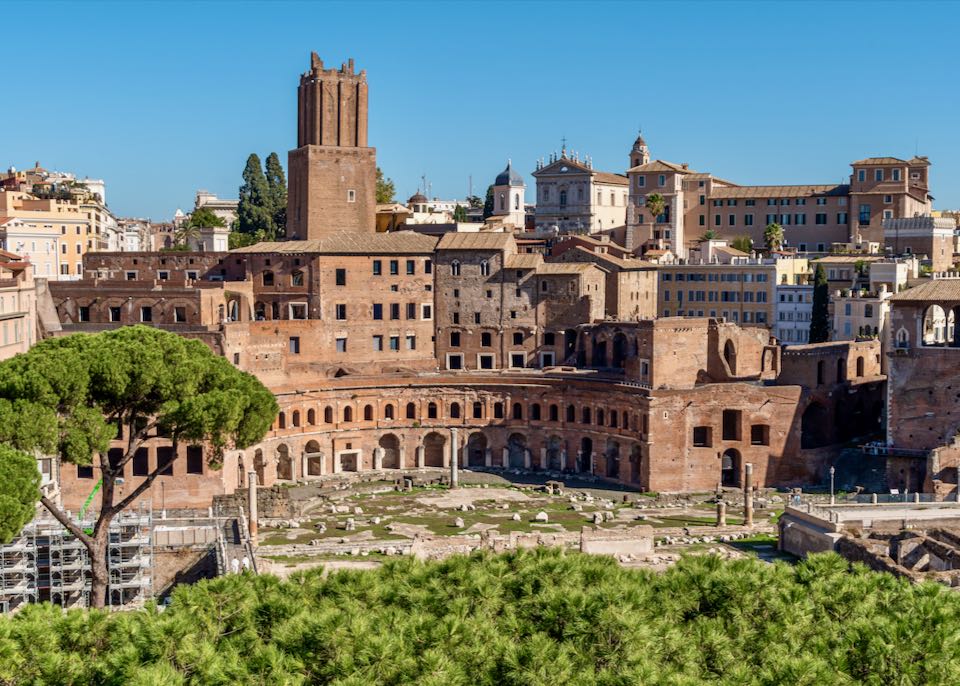
A towering red-brick edifice, Trajan’s Markets (Mercati di Traiano) were the colossal centerpiece of Trajan’s 2nd-century Forum, the last and most spectacular of the Imperial Forums. It was originally thought to have been an ancient shopping center, but scholars now believe it was designed to house the forum’s administrative offices. These days, it hosts a museum dedicated to the Imperial Forums’ history and architecture. On show are archaeological artifacts and architectural reconstructions, but the real star turn is the building itself, a huge three-story semicircle centered on a vast Great Hall. Up top there are great views over the forums.
7. Piazza Navona
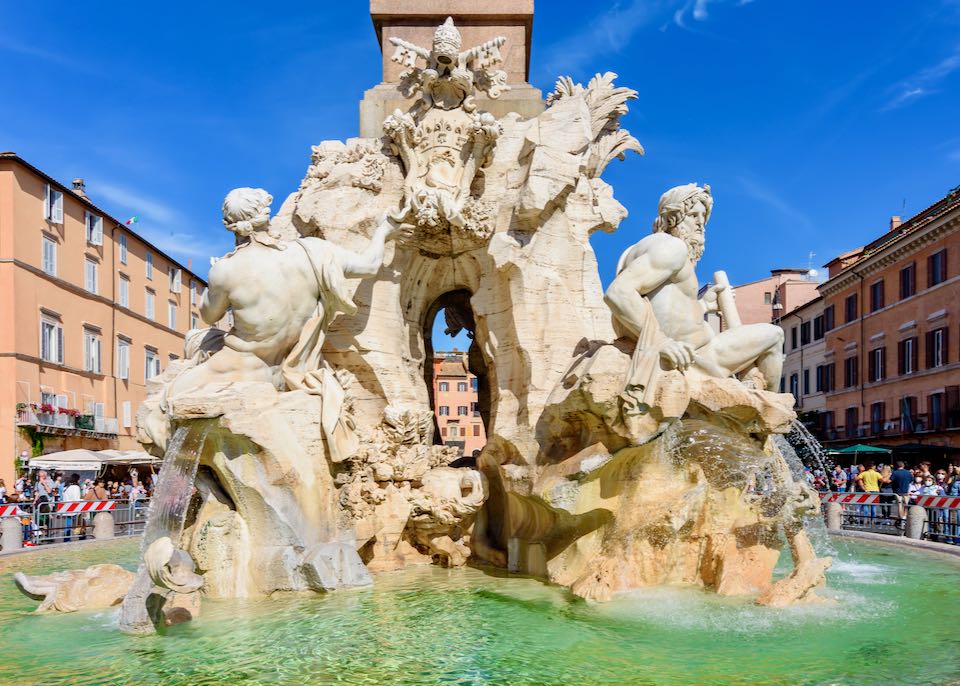
Nowhere is Rome’s timeless beauty encapsulated more perfectly than this gorgeous piazza in the heart of the historic center. Set over a 1st-century stadium – hence its elongated oval shape – it’s flanked by handsome baroque palazzi and centered on three ornamental fountains. The most spectacular of these is the central Fountain of the Four Rivers, a flamboyant baroque creation fashioned by Gian Lorenzo Bernini. Bernini was the undisputed star of Rome’s 17th-century art world, but he faced stiff competition from his hated rival, Francesco Borromini, author of the piazza’s landmark church, the Chiesa di Sant’Agnese in Agone. Borromini also had a hand in Palazzo Pamphilj, the elegant palace which today houses the Brazilian Embassy at the southern end of the square. Nowadays, the piazza is a great place to hang out and watch street artists at work. You can also go underground and explore Domitian’s ancient stadium beneath the square – the entrance is at Via di Tor Sanguigna 3.
8. Pantheon
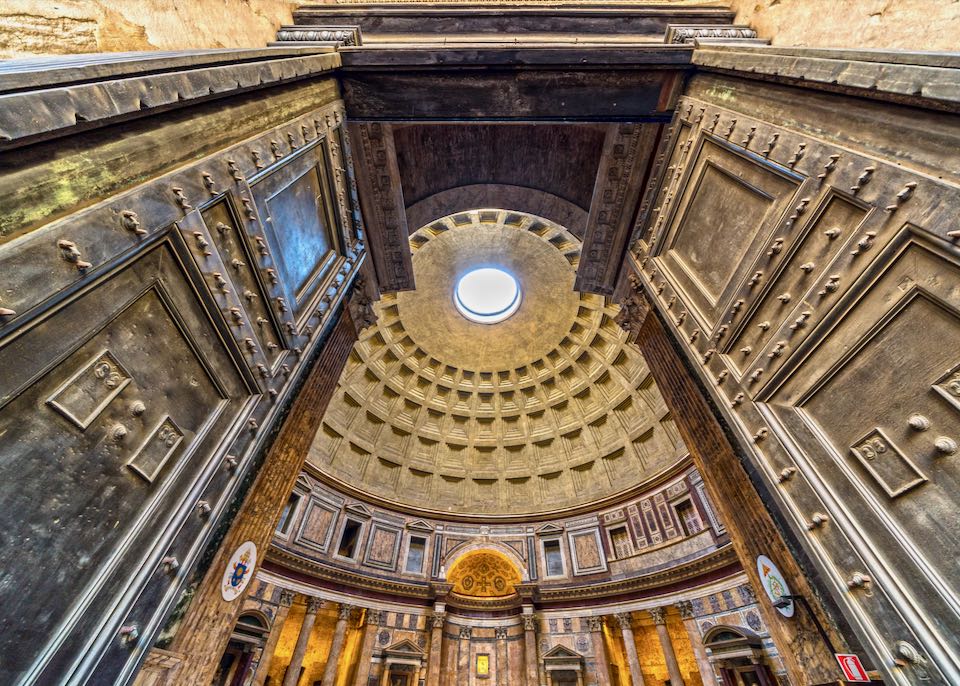
Alongside the Colosseum, this ancient temple is Rome’s most spectacular ruin. In fact, it’s hardly a ruin at all, having survived virtually intact since it was built by the emperor Hadrian circa AD 125. The Pantheon (from the Greek words pan, meaning all, and theon, meaning gods) was originally a temple dedicated to all the gods in Roman mythology. But in 608, it was consecrated as a Christian church and became the Basilica di Santa Maria ad Martyres, which remains its official title to this day. It’s a formidable structure. The entrance portico, fronted by 16 giant granite columns, leads into a cavernous, beautifully symmetrical interior decorated in lavish marble. Here you’ll find the tombs of kings Vittorio Emanuele II and Umberto I, as well as that of Renaissance artist Raphael. Up above, light (and rain) streams in through the oculus in the center of the dome. This vast concrete cupola was the largest in the world for centuries and is still regarded as the ancient Roman’s greatest architectural feat.
9. Trevi Fountain
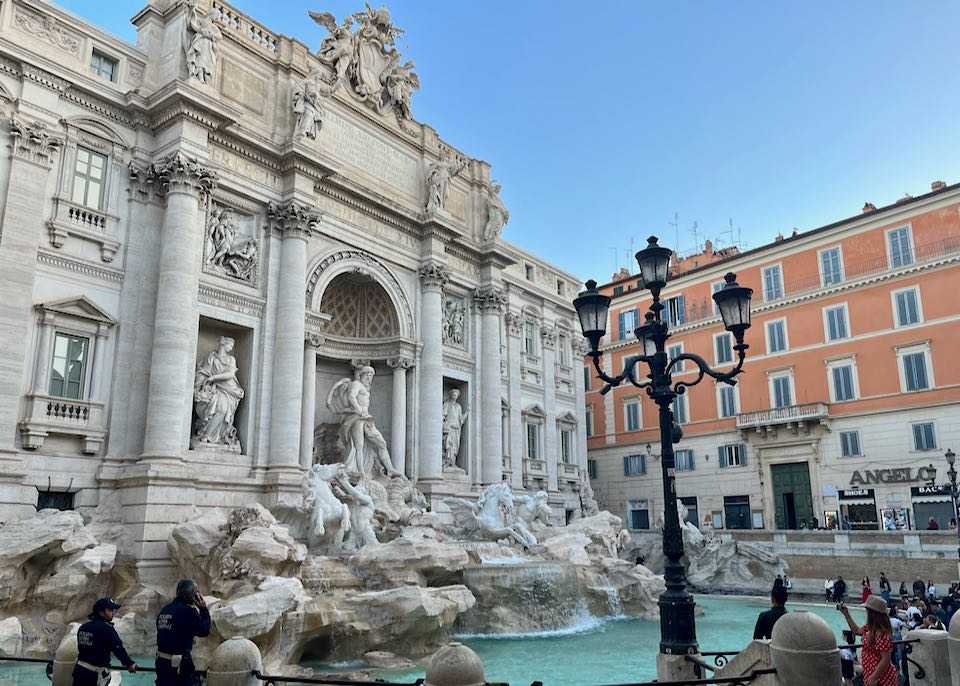
Rome’s largest and most celebrated fountain, and home to one of the city’s most popular rites of passage. According to tradition, throwing a coin into the Trevi Fountain fountain will ensure you’ll return to Rome one day. And judging by the €3000 or so that’s thrown in on an average day, a lot of people want to come back. (The money collected is donated to the charity.) The fountain was completed in 1762, having taken some 30 years to build. Its exuberant design is the work of artist Nicola Salvi and takes up the whole side of the 17th-century Palazzo Poli. The central character is the god Oceanus, who’s shown standing in a seashell-shaped chariot that’s being pulled by seahorses. Flanking him are two figures representing Abundance and Salubrity. Over the years, the fountain has featured in many films. Most famously, Anita Ekberg splashed around with Marcello Mastroianni in Federico Fellini’s La Dolce Vita.
10. St Peter’s Basilica
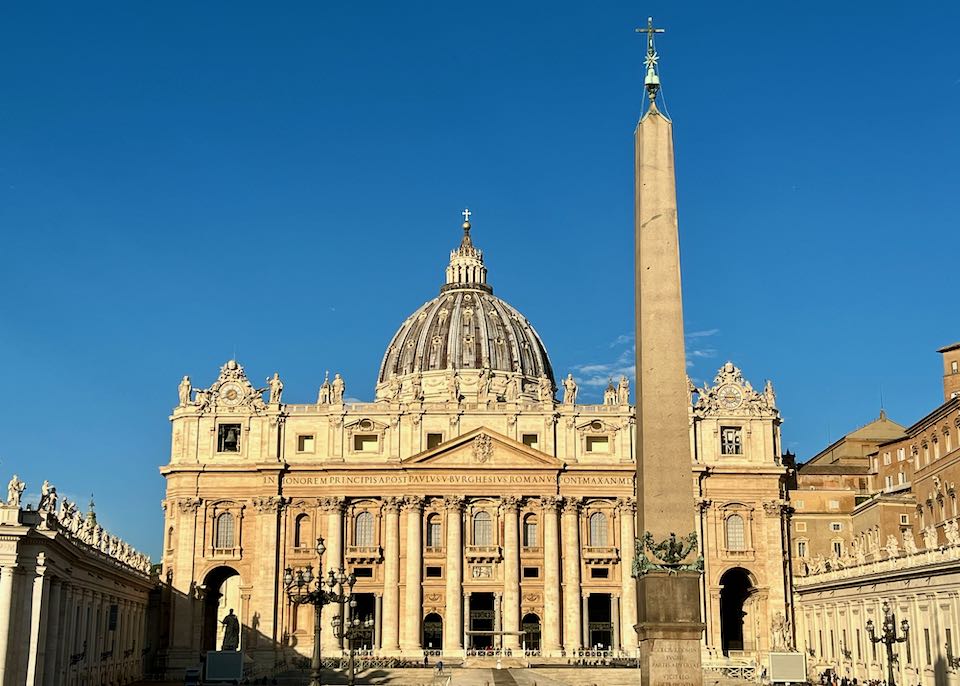
The Vatican’s monumental centerpiece, St Peter’s Basilica is the most important church in the Catholic world. For centuries it was the largest church in the world, and still today its size and opulence are staggering. The current basilica was built over a 4th-century church and consecrated in 1626 after some 120 years’ construction. Many of the top artists and architects of the Renaissance and Baroque eras worked on it, including Bramante, Raphael, Domenico Fontana, and Carlo Maderno. Michelangelo sculpted the Pietà statue just inside the main entrance and designed the basilica’s stunning dome, and baroque maestro Bernini created the baldachin over the main altar. Beneath the cavernous interior, you can explore the Vatican grottoes and, with prior reservation, visit St Peter’s tomb. Most people arrive at St Peter’s by way of Ottaviano metro station, but the best approach is along Via della Conciliazione. This monumental road leads straight to St Peter’s Square, commanding fabulous views of the basilica’s mighty façade. Note that strict dress codes are enforced, so if you want to go inside the basilica, make sure to cover your legs and shoulders.
11. Vatican Museums
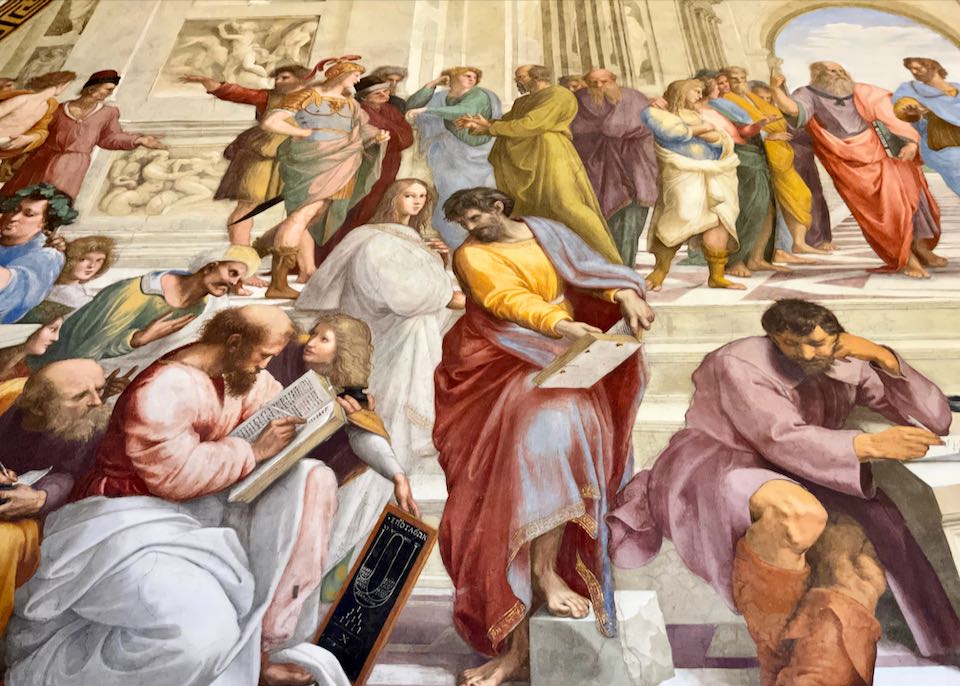
Home to the Sistine Chapel and the breathtaking art collection that popes have amassed over the centuries, this is one of the world’s great museums. It’s also one of Italy’s most visited and the queues to get in can be as mind-blowing as the art, so it pays to plan ahead – book tickets online or visit on a Tuesday or Thursday afternoon, generally the quietest times. The complex, housed in the Palazzo Apostolico, is huge with several kilometers’ worth of galleries and hallways. Even rushing through, you should reckon on at least three hours for a visit. It’s impossible to see every masterpiece here, but there are some you really wouldn’t want to miss: the Laocoön and Apollo Belvedere sculptures in the Museo Pio-Clementino, Raphael’s mighty fresco The School of Athens in the Raphael Rooms, and, of course, the Sistine Chapel. This cavernous chapel is home to two of Italy’s most revered works of art, both by Michelangelo. His celebrated ceiling fresco (1508-12) covers the entire 800 square-meter vault and depicts nine episodes from the book of Genesis. Equally as inspiring is his awe-inspiring Last Judgment (1535-41) on the west wall, showing God passing judgment over the souls of the dead.
12. Castel Sant’Angelo
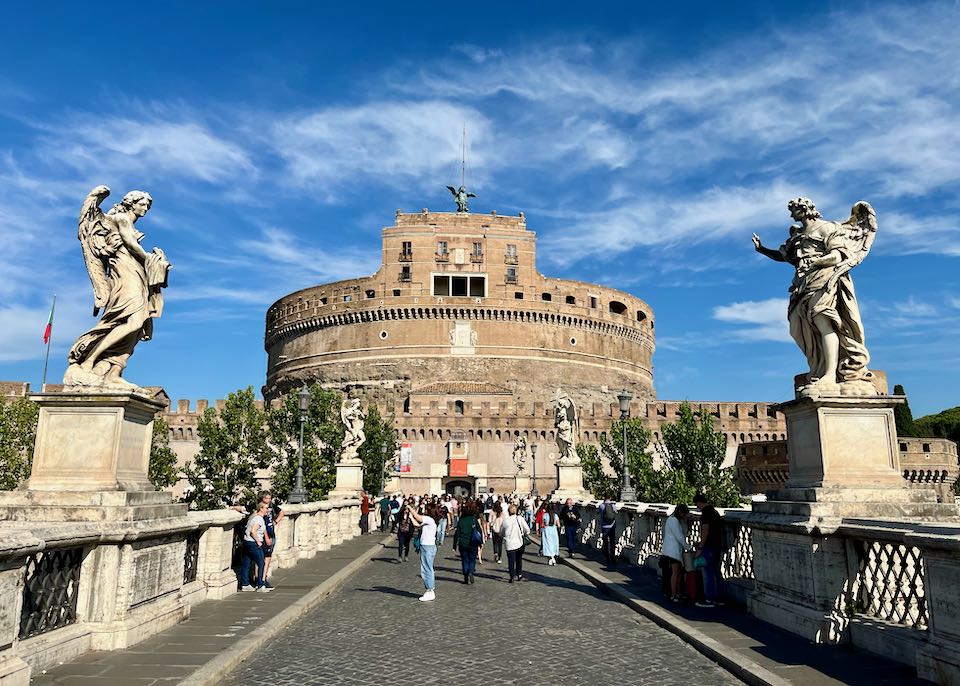
With its characteristic drum shape and riverside location, Castel Sant’Angelo is one of Rome’s most historic landmarks. Originally built as a mausoleum for the emperor Hadrian in 139 AD, it was subsequently fortified and taken over by the papacy, which used it as a safe refuge in times of danger. Pope Clement VII famously sheltered here during the 1527 Sack of Rome, reaching it by way of a secret passageway from the Vatican. The castle’s name, Castle of the Holy Angel, is a reference to a vision of an angel that Pope Gregory had here in 590. Nowadays, Castel Sant’Angelo is one of Rome’s most popular museums. Exploring it you can learn about its long, tumultuous history and visit the lavish papal apartments. Make sure to check out the Sala Paolina with its beautiful Renaissance frescoes and the stunning views from the terrace.
13. Church of Saint Louis of the French
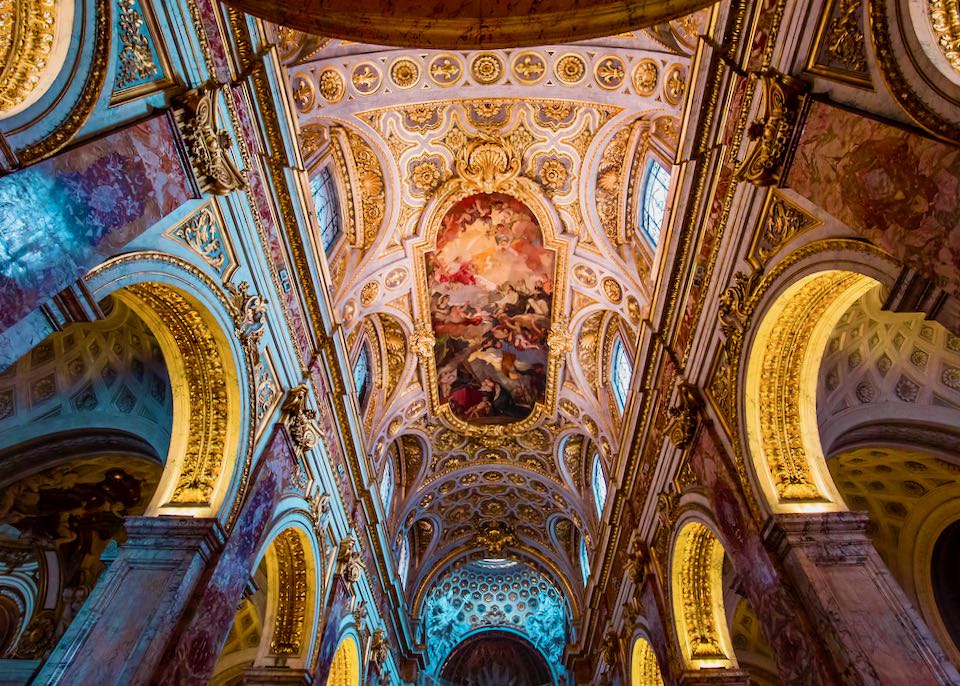
The historic church of Rome’s French community, the opulent baroque Chiesa di San Luigi dei Francesi is home to some truly fabulous artworks. Chief among them is a celebrated trio of Caravaggio masterpieces known as the St Matthew cycle. Painted between 1599 and 1602, these three works – the Calling of St Matthew, the Martyrdom of St Matthew and the Inspiration of St Matthew – hang in the last chapel on the left, the Cappella Contarelli. The artist originally submitted a canvas entitled The Angel and St Matthew for the chapel but it was rejected because its warts-and-all depiction of the saint was deemed scandalously irreverent. The Caravaggio paintings might be the church’s main drawcard, but there are several other important works harbored here as well. Of particular note is a cycle of frescoes by Domenichino illustrating episodes from the life of St Cecilia, patron saint of music and musicians.
14. Campo de’ Fiori
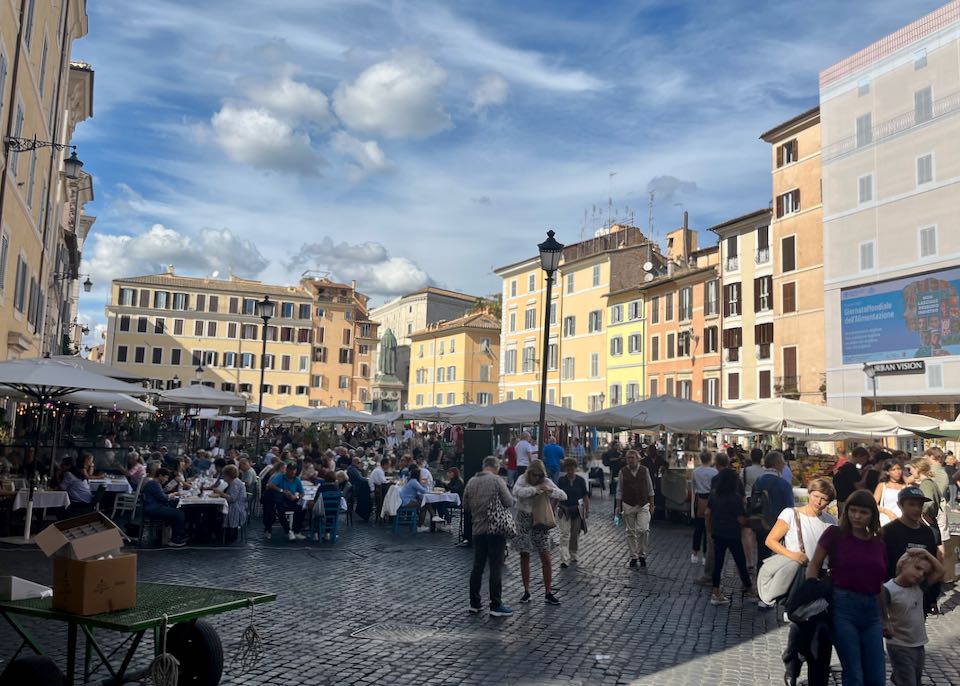
There’s always something happening in this vibrant square. Every weekday morning, colorful produce stalls take over the cobbled piazza for the traditional morning market. At lunchtime, the square-side restaurants and eateries do brisk business, and in the evening the square hosts a lively drinking scene, much frequented by young visitors and international students. In the center of the mayhem, the hooded figure of Giordano Bruno casts a sinister shadow – the piazza’s famous statue stands on the spot where the philosopher monk was burnt for heresy in 1600. A short hop from the Campo, Piazza Farnese exudes an altogether more refined atmosphere. Overlooking it is Palazzo Farnese, a model of Renaissance architecture and the current home of the French Embassy. The palazzo boasts some superb frescoes by Annibale Carracci, which can be admired on a guided visit – online booking is necessary.
15. Largo di Torre Argentina
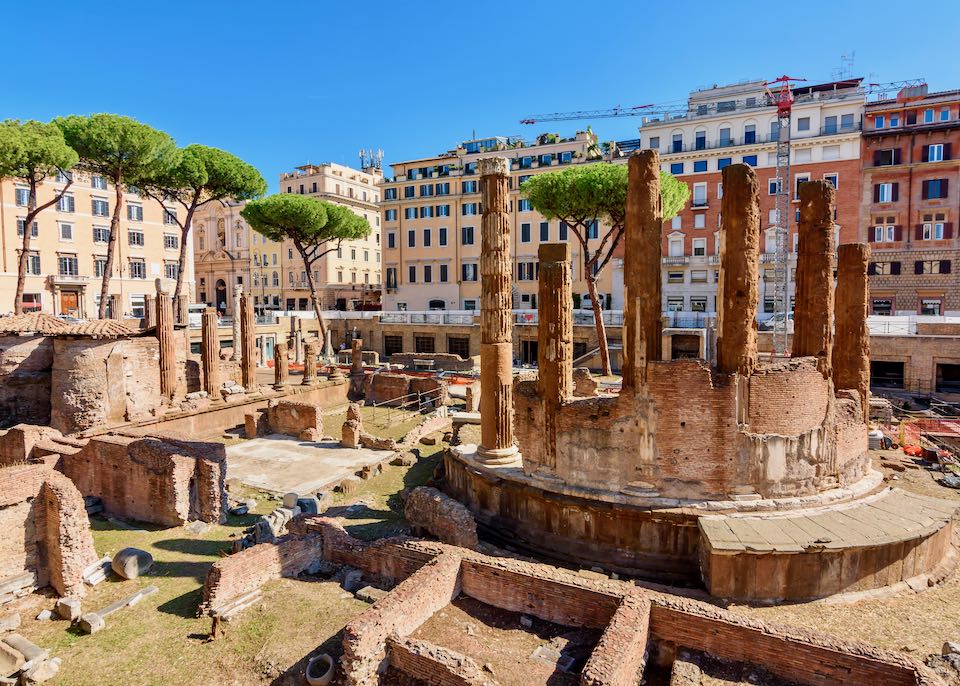
Most people pass straight through this busy transport hub, but the square is rich in historical interest. The main focus is the sunken area in the center known as the Area Sacra. This is where Brutus and his co-conspirators stabbed Julius Caesar to death on the Ides of March 44 BC in what was then part of the Theater of Pompey. The area is now occupied by the ruins of four Republican-era temples, the oldest of which dates back to the 3rd century BC. The area is out of bounds to humans but home to a thriving community of cats and a volunteer-run Cat Sanctuary. Teatro Argentina, Rome’s premier theater, sits on the western flank of the square. Rossini’s opera The Barber of Seville premiered here in 1816.
16. Piazza di Spagna & the Spanish Steps
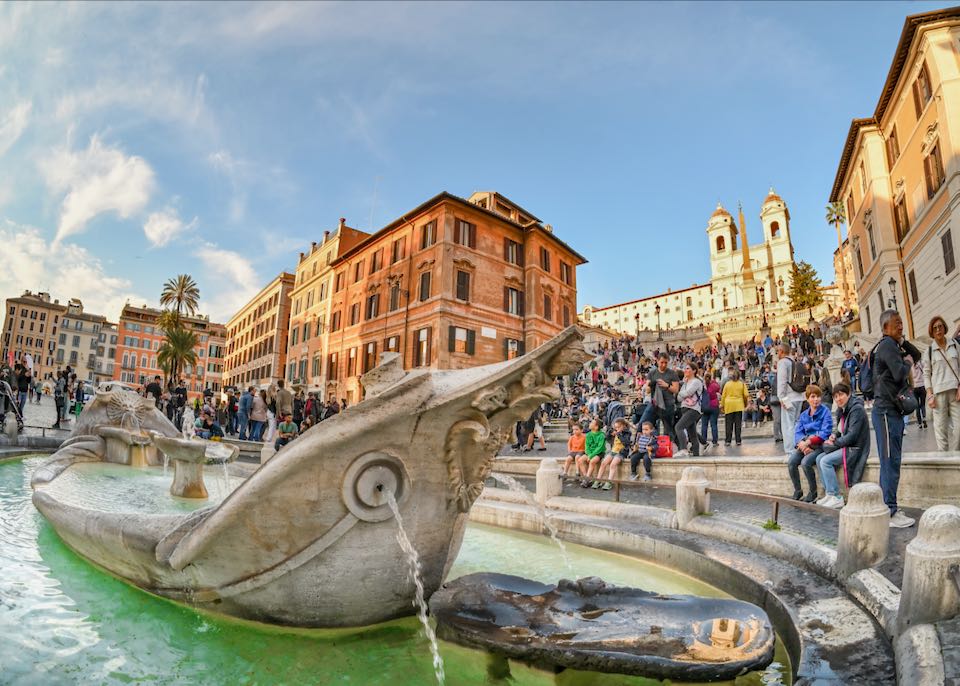
Gleaming in the wake of a recent makeover, Rome’s most famous staircase sweeps up from Piazza di Spagna. At some point, you’ll almost certainly find yourself passing through this busy square and enjoying a timeout on the Spanish Steps, which provide a welcome perch for weary legs. Make it to the top, though, and you’re rewarded with fantastic views from the landmark church, Trinità dei Monti. Despite their name, the Steps were not actually built by the Spanish – the name was a reference to the nearby Spanish Embassy to the Holy See. In front of the Steps sits the piazza’s fountain, known as the Barcaccia. Depicting a sunken boat, it was designed to be below street level to compensate for low water pressure. Leading off the piazza to the west is Via dei Condotti, Rome’s Fifth Avenue. Also of note is the house to the right of the Steps where Romantic poet John Keats spent his last few months. For the best photo ops, try to visit between mid-April and mid-May when hundreds of colorful azaleas are laid out on the Steps.
17. Piazza del Popolo
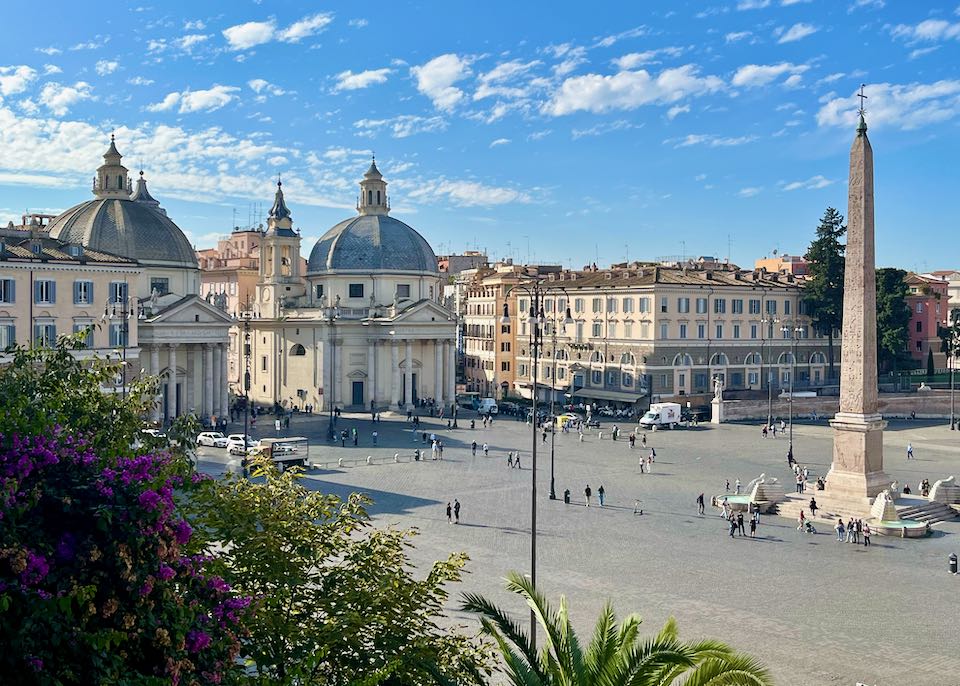
Piazza del Popolo is one of the city’s great squares, located at what used to be Rome’s main northern entrance. The piazza dates back to 1538 but owes its current look to a 19th-century makeover by the architect Giuseppe Valadier. Guarding the square’s southern entrance are the non-identical twin churches of Santa Maria dei Miracoli and Santa Maria in Montesanto – these mark the point where three of central Rome’s main roads converge – Via del Corso, Via del Babuino and Via Ripetta. Because of this, this part of Rome is known as the Tridente (Trident). Over on the other side of the square looms the piazza’s grand gate (the Porta del Popolo), created by Gian Lorenzo Bernini. The piazza has long been a lively hangout – in centuries past, public executions were carried out here, and today it’s often used for concerts and political rallies. It’s a great place for people watching.
18. Santa Maria del Popolo
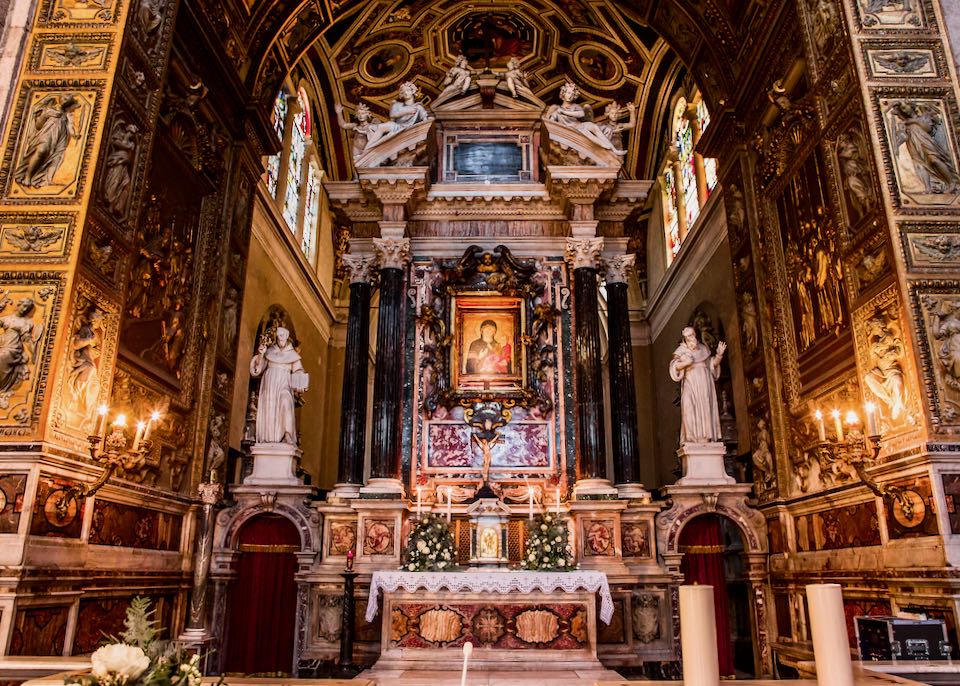
Boasting works by Pinturicchio, Raphael, Caravaggio, and Bernini, this is one of Rome’s richest art churches, though it’s often overlooked by visitors. It was originally built in 1099 to ward off the ghost of Nero, said to haunt the area, but was subsequently modified in the late 15th century. In the early 1500s, Bramante remodeled the choir and designed the apse which was then frescoed by Pinturicchio, one of the top artists of Renaissance Rome. Other highlights include the Chigi Chapel, which was planned by Raphael and completed by Bernini who added the statues of Daniel and Habakkuk. To the left of the main altar, the Cerasi Chapel contains two Caravaggio paintings: the Conversion of St Paul and the chillingly realistic Crucifixion of St Peter.
19. San Giovanni in Laterano
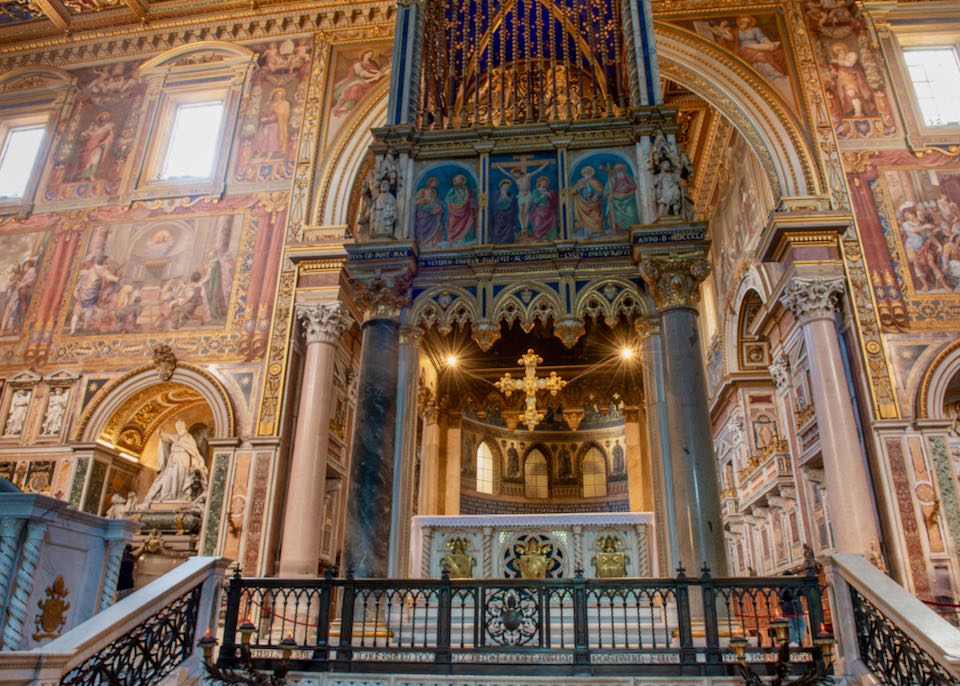
This landmark basilica is the Pope’s seat as the Bishop of Rome, and the oldest of the city’s four papal basilicas (the others are St Peter’s, Santa Maria Maggiore and San Paolo Fuori Le Mura). It was founded by Constantine in the 4th century, and for a long period was the main papal church. Over the course of its lifetime, it has been remodeled many times; much of its baroque interior dates to a 17th-century makeover by Francesco Borromini, and the huge white façade, complete with its 15 giant statues, was added in 1735. The echoing interior is a magnificent sight with its gilded ceiling, 13th-century mosaic floor, and a series of huge marble apostles. A towering Gothic baldachin, said to contain the heads of Saints Peter and Paul, stands over the main altar, whilst behind, sparkling mosaics adorn the vast apse. Don’t miss the tranquil 13th-century cloisters – accessible to the left of the altar – and, near the main entrance, a column sporting traces of a fresco by Giotto.
20. San Clemente Basilica
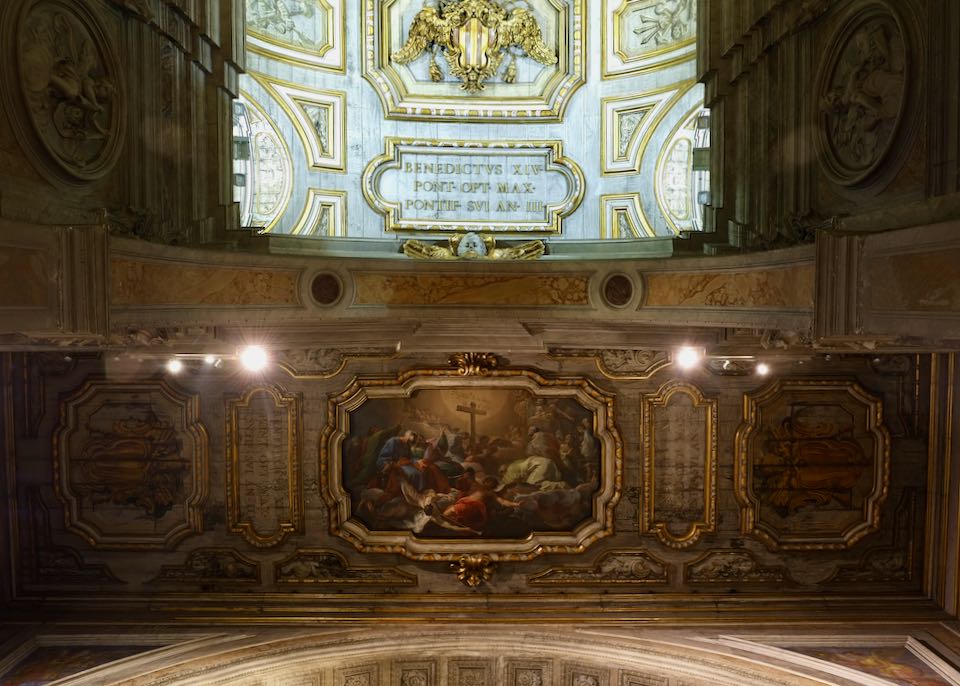
A short walk from the Colosseum, this 12th-century basilica strikingly illustrates Rome’s multi-layered past. For beneath the street-level church lie the remains of an earlier 4th-century basilica, which itself stands over the remnants of an ancient housing block and a 2nd-century pagan temple (Mithraeum). There’s some wonderful art in the main basilica, including a fabulous apse mosaic, the Triumph of the Cross, and a series of 15th-century frescoes in the Chapel of St Catherine. Underground, look out for some patchy 11th-century frescoes in the basilica inferiore and the Mithraic altar which shows a relief of the god Mithras sacrificing a bull. The pagan cult of Mithraism was very popular in ancient Rome, especially with members of the military, and temples were built across the city, mostly in underground locations.
21. The Borghese Galleries
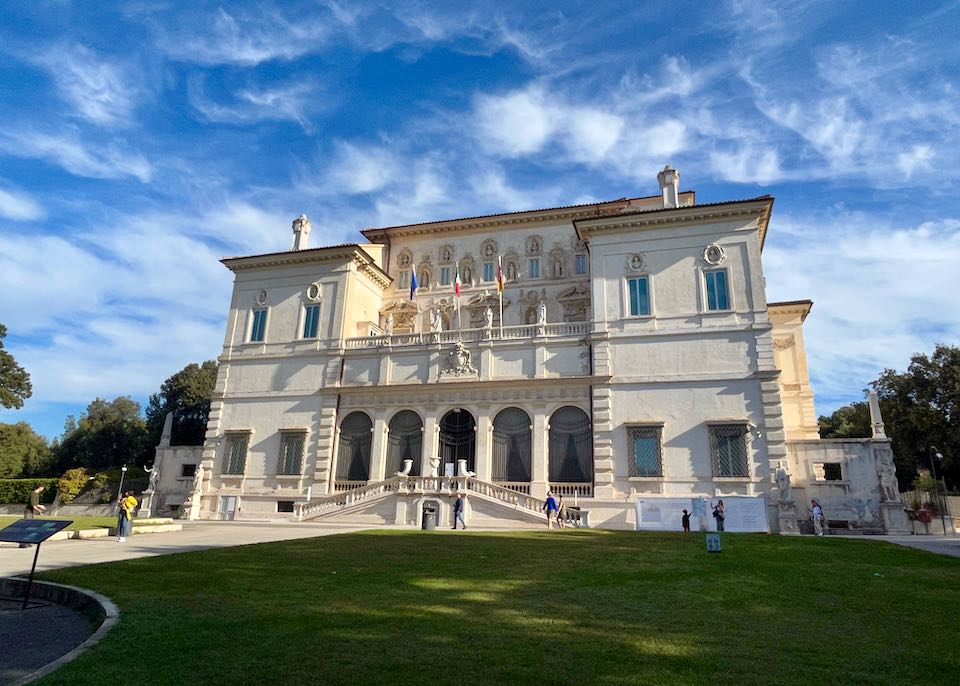
This fabulous museum is one of Rome’s best, a magnificent treasure trove of Renaissance and Baroque art. You need to pre-book tickets to visit – either online or by phone – but it’s so worth it. The museum’s collection was formed by Cardinal Scipione Borghese in the 17th century, and today it remains displayed in the villa he built to safeguard it. This elegant mansion, known as the Casino Borghese, is a sight in itself with its palatial rooms and opulent décor. The star exhibits are mainly on the ground floor. These include a languid depiction of Paolina Bonaparte Borghese, Napoleon’s sister, by Antonio Canova, and a series of mythical sculptures by Gian Lorenzo Bernini. Also on the ground floor is a room full of Caravaggio canvases, including the charming Boy with a Basket of Fruit. The most famous of the museum’s paintings is perhaps Titian’s Sacred and Profane Love, one of the many masterpieces on show in the upstairs picture gallery.
22. Villa Borghese
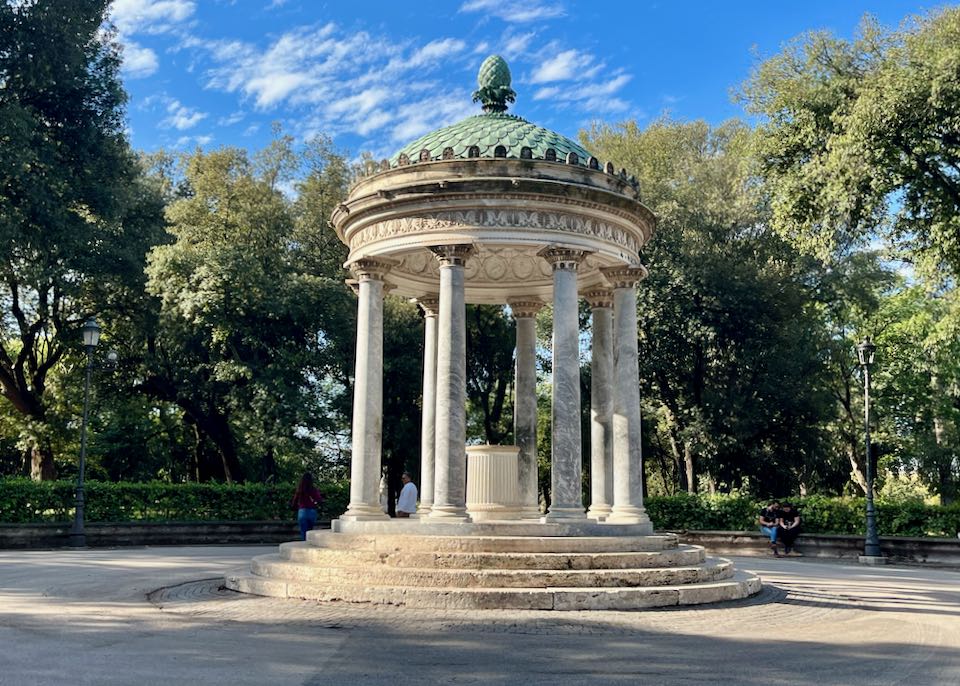
Rome’s Central Park is a great place to unwind and recharge your batteries. Covering about 80 hectares of grass and woodland, it encompasses what was once the 17th-century estate of Cardinal Scipione Borghese. Paths crisscross the greenery, leading to a small boating lake, the Giardino del Lago; a scenic arena called Piazza di Siena; and a lovely viewing balcony on the Pincio Hill. There are also a number of excellent museums dotted around the park, including the fabulous Borghese Galleries. Bike hire is available at various points, otherwise the park is easy to explore on foot.
23. The Villa Giulia National Etruscan Museum
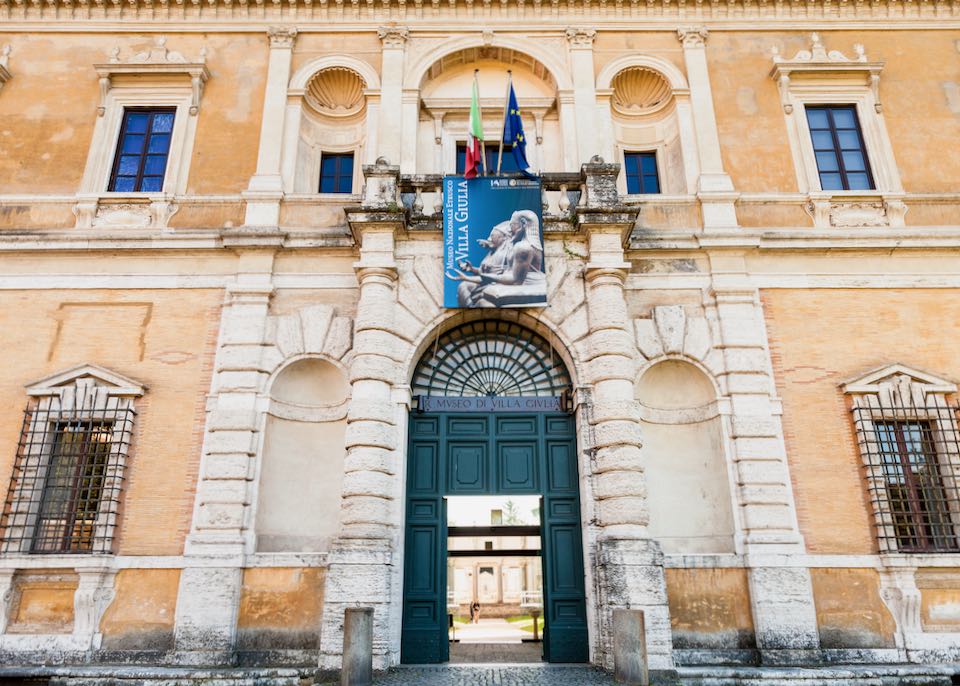
Italy’s premier collection of Etruscan treasures is on show at this lovely museum on the edge of Villa Borghese park. It’s a little way off the beaten track but well worth searching out. Exhibits, which range from gold jewelry to ceramics, vases, and bronzeware, are housed in Villa Giulia, an elegant Renaissance mansion built for Pope Julius III. Many artifacts were unearthed at sites in northern Lazio such as Cerveteri and Tarquinia, both important centers in the pre-Roman Etruscan age. A collection highlight is the celebrated 6th-century sarcophagus known as the Sarcophagus of the Betrothed.
24. Appian Way
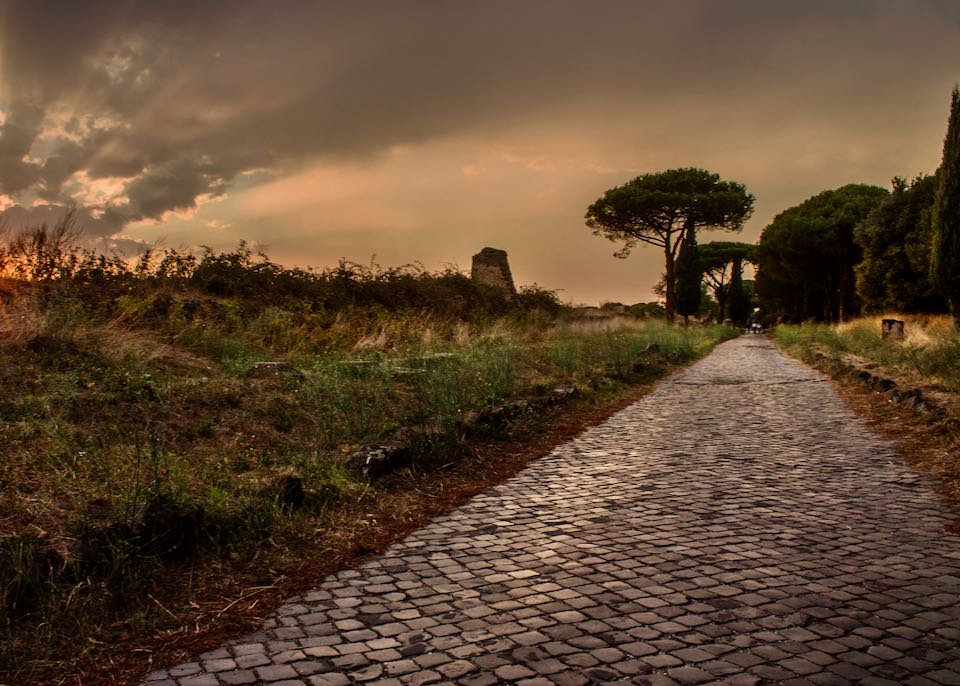
Known to Italians as Via Appia Antica and to the ancients as the ‘Queen of Roads’, the Appian Way was the most famous highway in the ancient world. It ran for about 540km, connecting Rome with the southern Adriatic port of Brindisi. The oldest section – from Rome to Capua near Naples – was laid in the 4th century BC by Appius Claudius Caecus, after whom it’s named. This stretch was later extended and the road was completed in 190 BC. Parts of the original roadway still survive, complete with heavy basalt paving stones. These days, the Appia’s main draws are the catacombs that lie beneath it. From the 2nd century, early Christians dug about 300km of underground tunnels to use as burial chambers – Roman law forbade burial within the city walls and land was too expensive for many to buy. Over the next few centuries, hundreds of thousands of people were buried in them, including many saints, martyrs, and popes.
25. Bocca della Verità
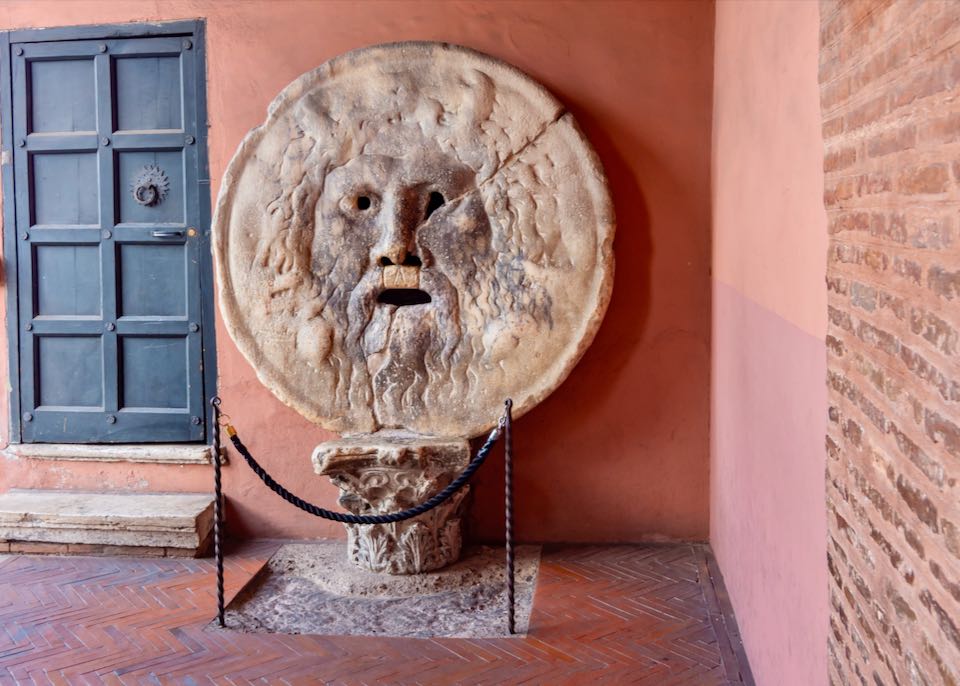
To look at, the Bocca della Verità (Mouth of Truth) is a curious but not particularly amazing archaeological artifact – a large marble disk with an old man’s bearded face carved into it. But what keeps the crowds coming – and there’s almost always a queue of people waiting to take a selfie with it – is the legend that surrounds it. According to a long-standing myth, the mouth is a kind of ancient lie-detector that will slam shut on anyone who tells a lie with their hand inside. Few people appear to have lost their fingers, but that didn’t stop Gregory Peck fooling Audrey Hepburn in the classic movie Roman Holiday. The Mouth, which was probably part of an ancient fountain, sits in the porch of the Chiesa di Santa Maria in Cosmedin, an attractive 12th-century church.
26. Altar of the Peace of Agustus
Modern architecture meets ancient art at this tiny museum. Designed by US architect Richard Meier, a stunning glass and travertine pavilion houses the Altar to the Augustan Peace, Ara Pacis Augustae, a huge marble altar created in 9 BC to celebrate the peace established by the emperor Augustus. The altar originally stood in the Campus Martius, just to the south of its current site. Over the centuries, it was picked apart by art collectors, and it was only in 1937 that it was re-configured to its original form. The result is one of the great masterpieces of classical sculpture. Its flanks are decorated with reliefs showing a procession of diverse characters, including members of the Imperial family (Augustus, his wife Livia, and adopted son Tiberius) and the general Marcus Agrippa.27. Catacombs
There are several creepy catacombs you can explore on the Appian Way. The largest and most popular are the Catacombs of San Callisto. Visits here, like for all the catacombs, are by guided tour – with about 20km of underground tunnels you wouldn’t want to get lost in the dark. These catacombs date to the 2nd century AD and were an extremely popular burial site – hundreds of thousands of people were laid to rest here including dozens of martyrs and 16 popes. A short walk away, San Sebastiano Basilica stands over a second catacomb complex, the Catacombs of San Sebastiano. Before heading underground, take time to have a quick look around the basilica, which was built on the spot where St Sebastian was buried and contains one of the arrows used to kill him. The catacombs have several subterranean mausoleums and lots of ancient graffiti dedicated to saints Peter and Paul, whose relics were supposedly protected here during a period of Christian persecution.28. National Museum of Ancient Art – Palazzo Barberini
A swaggering 17th-century palace, Palazzo Barberini houses the fabulous art collection of the Galleria Nazionale d’Arte Antica. The palace is one of Rome’s great baroque buildings, a towering mansion built at the behest of the Barberini Pope Urban VIII. Many of the big-name architects of the era worked on it, including bitter rivals Bernini and Borromini who both contributed monumental staircases. The gallery is on the building’s first floor and contains some stunning Renaissance and Baroque works. There’s a famous Raphael painting of his mistress, the Fornarina, and Hans Holbein’s celebrated portrait of King Henry VIII. Caravaggio gets in on the act with his graphic vision of Judith Beheading Holofernes. Trumping them all, though, is Pietro da Cortona’s awesome fresco Triumph of Divine Providence in the main hall.29. National Roman Museum: Palazzo Massimo alle Terme
Behind the austere walls of this Renaissance palazzo lies one of Rome’s great museums, the National Roman Museum. Many people overlook it, but go inside and you’re rewarded with some truly exceptional works of ancient art. The ground and first floors are largely given over to classical sculpture: look out for sporty works like the Boxer and the Discus Thrower, and a celebrated depiction of a Sleeping Hermaphrodite. More than the sculpture, though, the museum’s real star turns are the brilliant mosaics and frescoes on the second floor. These originally adorned smart Roman villas such as that of Livia, wife of the emperor Augustus. Gorgeously colorful frescoes from her dining room cover almost a whole room with their florid images of a lush, blooming garden. Note that the museum’s entry ticket gives admission to the other three seats of the National Roman Museum.30. San Pietro in Vincoli
A massive Michelangelo sculpture and a miraculous set of chains worn by St Peter are the main draws to this basilica. The chains, which are now displayed under the altar, are the subject of a traditional miracle story. This holds that when the chains St Peter wore in Rome’s Mamertine prison were placed with those used to bind him in Jerusalem, they miraculously joined together to form the set you see today. Michelangelo’s representation of Moses (1515) makes a powerful impression: Showing a muscular man with a Gandalf-like beard and two stubby horns sticking out of his head – the result of a biblical mistranslation which resulted in ‘horns’ rather than ‘rays of light’ – it was originally intended to be part of a huge tomb for Pope Julius II. However, the plan never came to fruition and the tomb remained forever unfinished.31. Santa Maria Maggiore
This monumental church, the most central of the four patriarchal basilicas, is one of Rome’s oldest. Dating to the mid-5th century, it sits on the summit of the Esquiline Hill on the site of a miraculous snowfall. According to legend, the Virgin Mary appeared to Pope Liberius in a dream on the night of 4 August 352 AD and told him to build a church on the spot where he’d find snow the next morning – an unlikely event given Rome’s sweltering summer temperatures. But the snow duly fell and the basilica was built. The snowfall is commemorated every 5 August by the release of thousands of white flower petals. The basilica has been modified many times over the centuries, although it has maintained its original interior structure. Outside, the 75m high bell tower is Rome’s tallest, and the ornamental façade dates to the 18th century. Inside, you’ll find some exceptional 5th-century mosaics above the nave and apse – though they can be difficult to make out so far above you. Various popes are buried in the basilica as well as the famous baroque artist Gian Lorenzo Bernini.32. Palazzo del Quirinale
Rome’s presidential palace sits atop the Quirinal hill, one of Rome’s original seven hills. Built in the mid-16th century, it served as the pope’s summer residence until Italian Unification when it was taken over by the king and became Italy’s royal palace. Then, following Italy’s 1946 vote to abolish the monarchy and become a republic, the palace once again changed hands – this time becoming the official seat of the President of the Republic. Architecturally, it’s an impressive work of baroque styling; many big-name architects worked on it, including Domenico Fontana, Carlo Maderno, and Gian Lorenzo Bernini, who added the long wing that runs along Via del Quirinale, known as the manica lunga or long sleeve. Visits, which must be booked in advance, take in its sumptuously decorated reception rooms, culminating in the glittering Grand Ballroom. Over the square, the palazzo’s former stables, the Scuderie del Quirinale, now host major art exhibitions.33. Santa Maria in Trastevere
This hidden gem of a basilica is one of Rome’s more low-key churches – at least from the outside, where it discreetly sits on Piazza Santa Maria in Trastevere. But go through the porticoed entrance and it’s a different story: the church’s columned interior boasts some of Rome’s most glorious mosaics. The best of these are the shimmering 12th-century apse designs that show Christ and a string of saints, prophets and popes. The 4th-century basilica is the oldest in Rome dedicated to the Virgin Mary and stands on the site where a fountain of oil is said to have miraculously sprung from the ground. The exact spot is marked with an inscription – Fons Olei. It was later rebuilt and the version you see today dates from the 12th century.34. Doria Pamphilj Museum
Housed behind the unassuming grey walls of Palazzo Doria Pamphilj, this excellent museum harbors one of Rome’s greatest private art collections. Artists represented include Raphael, Titian, Tintoretto, and Caravaggio, as well as several important Flemish painters such as Pieter Brueghel the Elder. The palazzo is the historic residence of the aristocratic Doria-Pamphilj dynasty and is still owned by the family. Inside, it’s a lavish affair – the result of an 18th-century makeover – with opulent galleries decked out with frescoes, acres of gold gilt, and sparkling chandeliers. Of the many masterpieces on show, the most famous is a lifelike portrait of Pope Innocent X by the Spanish artist Velázquez. The rather grumpy-looking pontiff, a member of the Pamphilj family, is also depicted in a bust by Bernini.35. Caracalla Baths
The colossal remains of emperor Caracalla’s 3rd-century baths complex are among Rome’s most majestic ruins. They’re not especially well-labeled, so it can be hard to know what you’re looking at, but the sheer size of them gives a good idea of how big the original structure must have been. In its heyday, it comprised swimming pools, gyms, libraries, galleries, shops, and gardens, and could accommodate around 1,600 people. The main block of ruins is centered on the frigidarium (cold room) and two lateral palaestras (porticoed exercise yards). Originally, these would all have been connected to a tepidarium (warm room), caldarium (hot room), and an uncovered natatio (swimming pool). Opera lovers should check out the summer season of performances staged in the ruins.36. Non-Catholic Cemetery
Also known as Rome’s Protestant Cemetery, this walled graveyard is the final resting place of many famous people, including the Romantic poets Keats and Shelley. It’s a surprisingly attractive place with rows of carefully tended gravestones, trimmed hedges, and tall, towering trees. Keats’ grave is in the tranquil grassy section to the left of the entrance, inscribed: ‘Here lies One Whose Name was writ in Water’. Nearby, there are benches where you can sit and enjoy the peace. Another more flamboyant tomb is that of artist William Wetmore and his wife, with its moving sculpture of the Angel of Grief. Looming over the cemetery is the great white bulk of Rome’s very own great Pyramid. This striking landmark was built in the 1st-century BC as a tomb.37. National Museum of Modern and Contemporary Art
This fantastic modern art museum makes a great sightseeing break from ancient ruins and baroque churches. Known in Rome as GNAM (Galleria Nazionale d’Arte Moderna), it occupies a giant belle époque palace and contains Italy’s largest collection of modern art, with works by many big-name international artists. From Italy, there are sculptures by neo-classical maestro Antonio Canova and futurist Umberto Boccioni, as well as canvases by Modigliani and Giorgio de Chirico. From France, there are masterpieces by the likes of Cézanne, Rodin, Degas, Monet, and Vincent Van Gogh, whilst global superstars Gustav Klimt, Jackson Pollock, Alexander Calder, and Alberto Giacometti are all represented.38. MAXXI
MAXXI, or to give it its full title Museo Nazionale delle Arti del XXI Secolo (National Museum of 21st-Century Art), is Rome’s top contemporary art museum. It has a permanent collection of some 300 works, but more interesting are the temporary exhibitions it stages. These usually feature innovative and avant-garde artists working around the world today – check the website for what’s on. The building housing the museum is a spectacle in itself – in a former life it was a military barracks, but after a radical overhaul by Anglo-Iraqi architect Zaha Hadid it is now a striking beacon of modern architecture full of sweeping curves and intersecting geometric forms.39. Auditorium Music Park
Rome’s avant-garde arts center revolutionized the city’s cultural scene when it opened in 2002. Not only was its contemporary design (the creation of starchitect Renzo Piano) unlike anything Rome had seen before, but it provided the city with a much needed modern concert venue. Performances are now staged here in three grey, pod-like halls and, in good weather, in a 3000-seat open-air theater. Gigs run the gamut from classical music – the Auditorium is home to Rome’s world-class Santa Cecilia orchestra – to rock, jazz, and world music. The Rome film festival is also held here; as are exhibitions, lectures, and many other cultural events. Even if you’re not attending an event, the Auditorium is well worth checking out. There are guided tours and a small museum showcasing archaeological artifacts unearthed during its construction.40. San Paolo Fuori Le Mura
A popular pilgrimage site, this patriarchal basilica is the largest church in Rome after St Peter’s. As its name (St Paul’s Outside the Walls) suggests, it’s located some way out of the historic center, which means you’ll need transport to get here – the easiest way is to take metro line B to San Paolo. The basilica’s origins date to the 4th century when it was built by the emperor Constantine on the site of St Paul’s burial. However, a fire in 1823 pretty much destroyed that church and the basilica you see today is a reconstruction of the original. Highlights include some surviving 5th-century mosaics in the triumphal arch and the beautiful 13th-century cloister. Also, look out for the papal portraits under the side windows. According to legend, the world will fall when there’s no more room for another picture.41. National Roman Museum: Diocletian Baths
Showcasing prehistoric artefacts and ancient Roman epigraphs, this historic museum occupies the hulking remains of the Baths of Diocletian. In the 4th century, this was Rome’s largest and most spectacular baths complex, capable of accommodating up to 3000 people at any one time. Nowadays, it houses the original seat of the National Roman Museum, and, in the massive frigidarium (cold room), the Basilica of Santa Maria degli Angeli, Michelangelo’s last architectural project. The main part of the museum is given over to a comprehensive collection of ancient Roman inscriptions and written texts. But you can go even further back in time in the galleries over the main cloister, which trace the development of the Bronze and Iron Age Latian culture. Outside, the beautiful space known as the Michelangelo Cloister is littered with sculptures, statues and ancient sarcophagi. Note that the museum’s entry ticket gives admission to the other three seats of the National Roman Museum.42. Santa Maria Sopra Minerva
The only Gothic church in Rome, this art-rich basilica stands on the site of a pagan temple to the goddess Minerva – hence its name, St Mary Over Minerva. Little remains of the original 13th-century church, but the current version more than makes up with some great works of art. Chief among these is a Michelangelo sculpture of Christ Bearing the Cross (1520), Jesus’ modesty preserved by some artfully positioned drapery. This wasn’t part of Michelangelo’s original design and was added well after the statue had been finished. Elsewhere, look out for some wonderful frescoes by Filippino Lippi in the Carafa Chapel, and several grand papal tombs. Buried in the church is St Catherine, whose headless body lies under the main altar – her head is in Siena. Outside the church, you’ll find Bernini’s much-loved statue of an elephant carrying an Egyptian obelisk; the curious design was conceived to illustrate how wisdom (the obelisk) should always be founded on moral strength (the elephant).43. Chiesa del Gesù
The Jesuits’ opulently decorated mother church is steeped in history. The order’s founder, St Ignatius Loyola, lived here from 1544 to 1556, and during the Counter-Reformation (approximately the late 16th to mid-17th centuries), its grand architecture played an important role as a showcase for Catholic authority. It impresses from the onset with an imposing two-tiered façade, the work of Giacomo della Porta, and boasts a lavish baroque interior. Inside, check out the astonishing ceiling fresco, the Triumph of the Holy Name of Jesus (1679), by Baciccia, and the Chapel of St Ignatius Loyola with its sumptuous altar by Andrea Pozzo. You can also visit the rooms where St Ignatius lived, accessible via a door to the right of the main church entrance.44. National Roman Museum: Palazzo Altemps
Housed in a lavishly decorated 15th-century palazzo near Piazza Navona, this branch of the Museo Nazionale Romano boasts a stunning collection of classical sculpture. Many of the pieces come from a celebrated collection amassed by Cardinal Ludovico Ludovisi in the 17th century. Headline exhibits include the Ludovisi Throne and the Ludovisi Ares, a 2nd-century BC representation of the god Mars as a young man. This is one of several pieces that was restored in the 17th-century, in this case by Bernini, who added its right foot. Another highlight is the Gaul Killing Himself and His Wife, which shows a Gaul plunging a knife into his chest whilst holding up a dying woman. Note that the museum’s entry ticket gives admission to the other three seats of the National Roman Museum.45. The Tempietto
A small temple on the Janiculum Hill, this out-of-the-way gem is one of the great masterpieces of Renaissance architecture. Created by Donato Bramante in 1502, it’s not a big building, but it was hugely influential in its day with its elegant proportions and harmonious, classically-inspired look. The architect is said to have based his design on the Temple of Vesta at Tivoli, and the result is a circular construction capped by a dome and surrounded by 16 Doric columns. The temple sits in the courtyard of the Chiesa di San Pietro in Montorio, supposedly on the spot where St Peter was crucified. It’s quite a steep walk to get to the church from Trastevere but it’s well worth it for the Tempietto and the great views over the city’s rooftops.

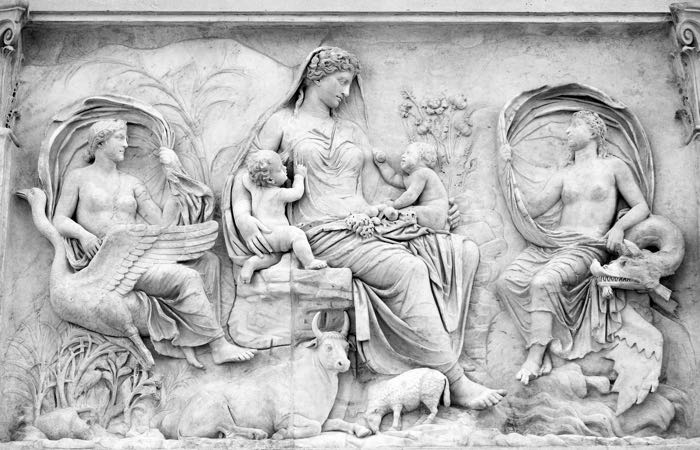
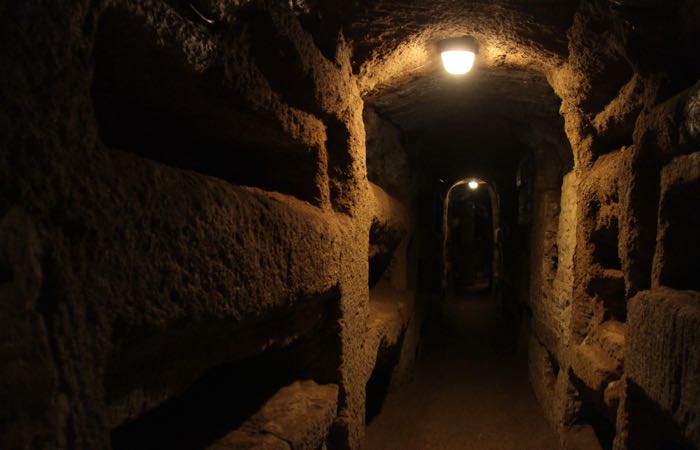
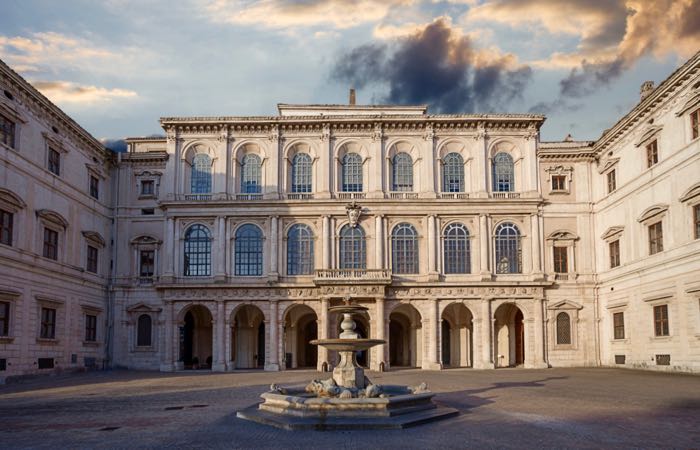
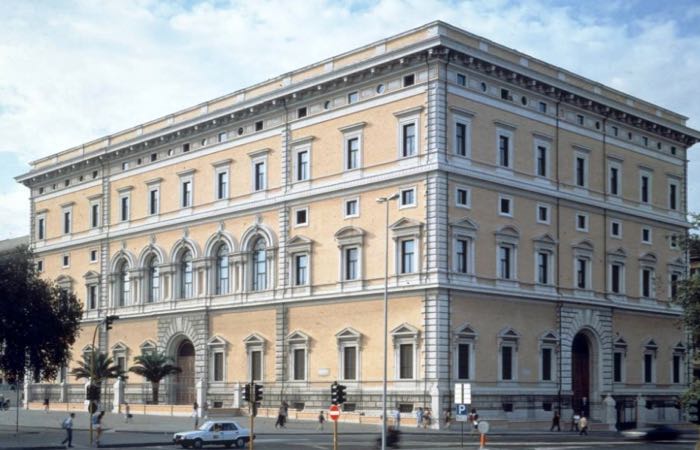
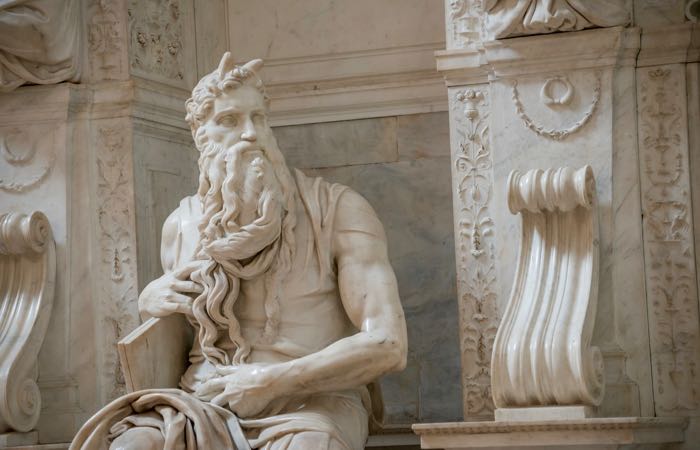
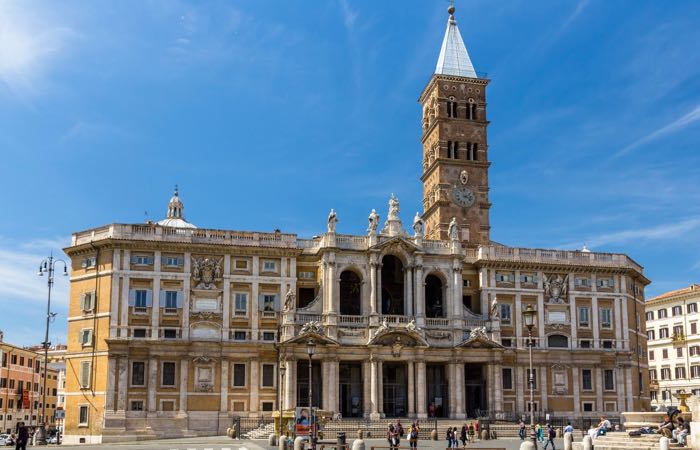

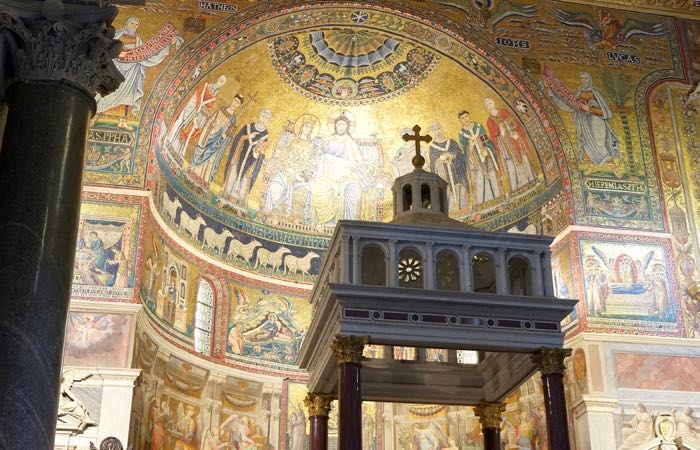
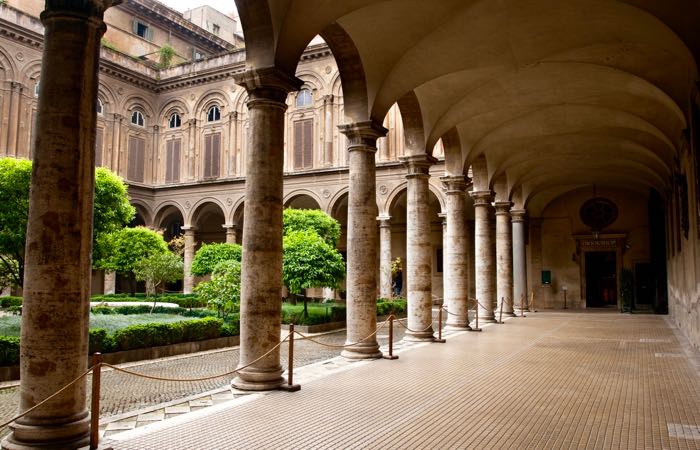
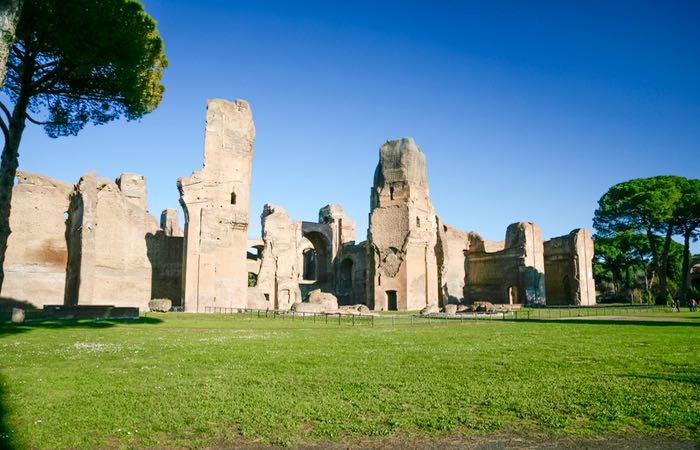
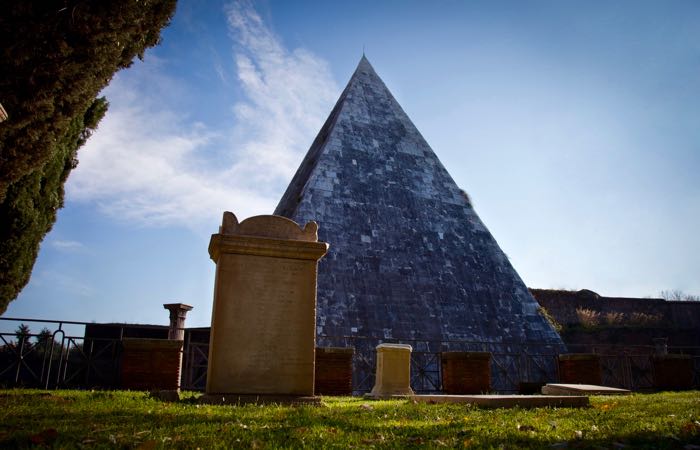
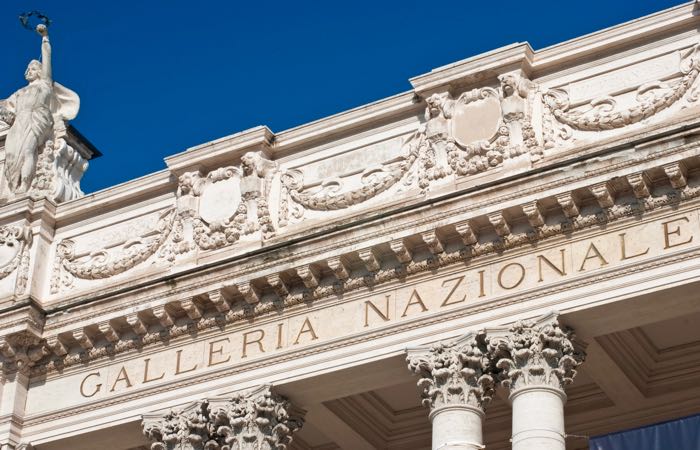
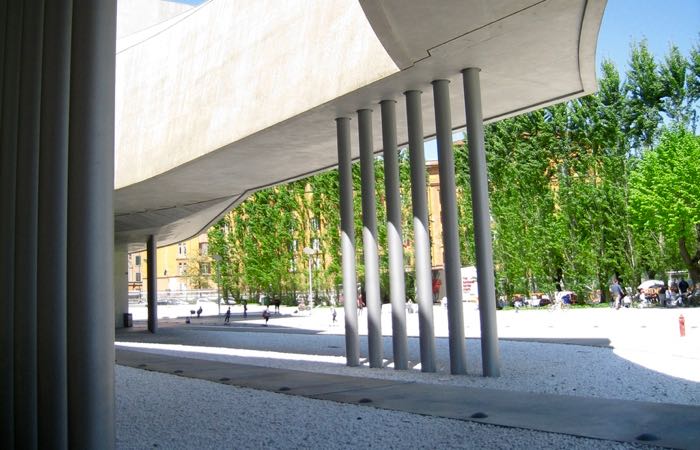

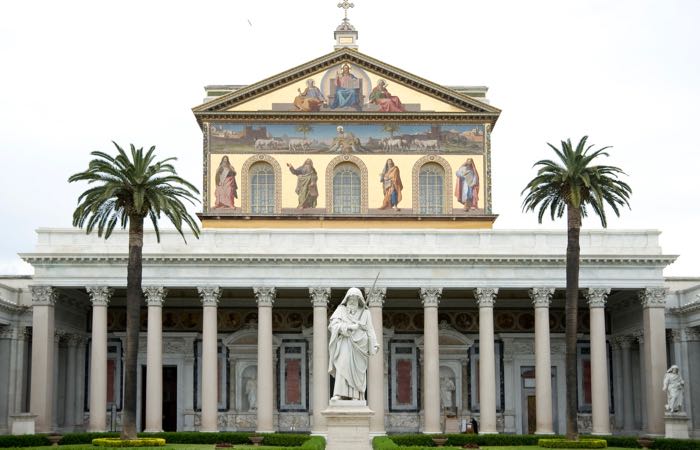
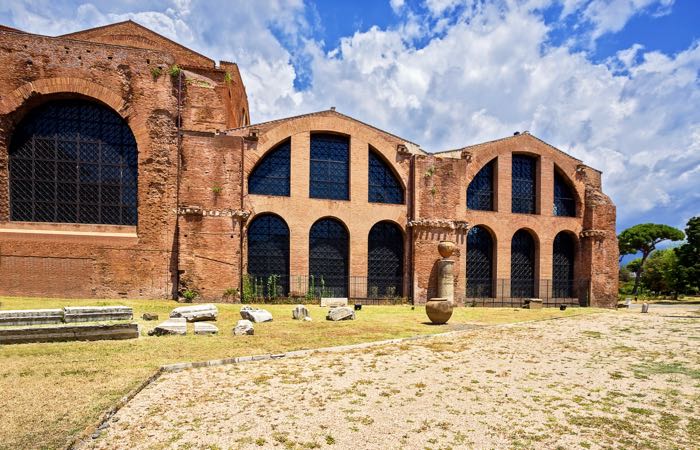
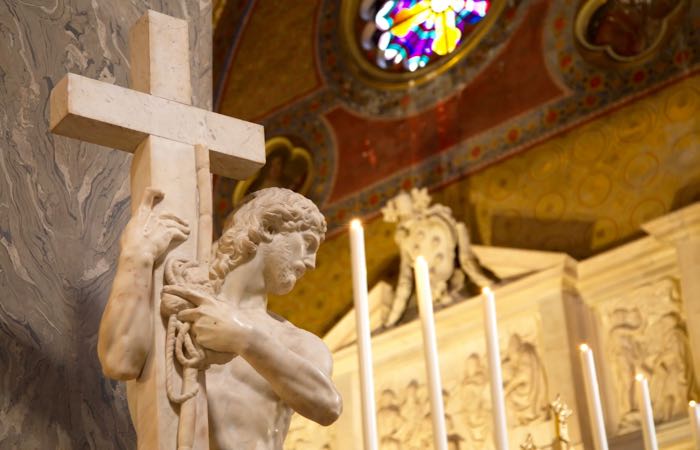
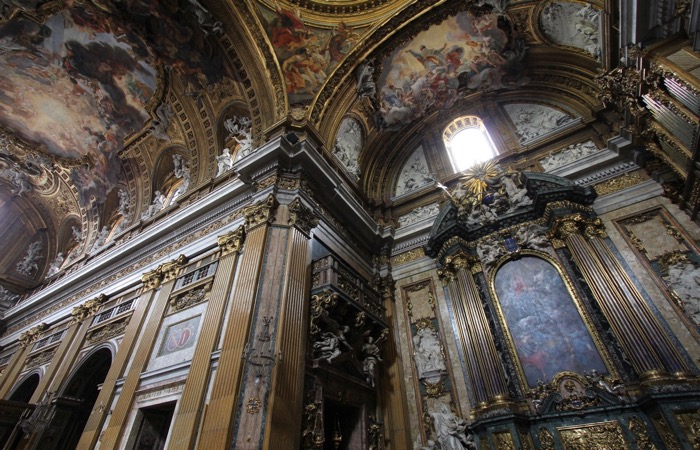
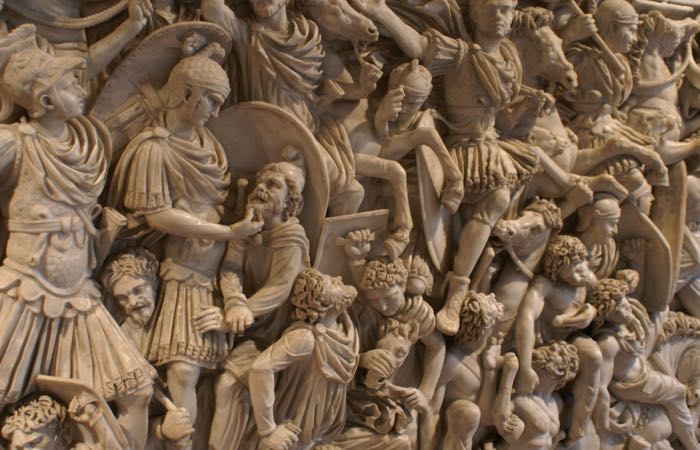
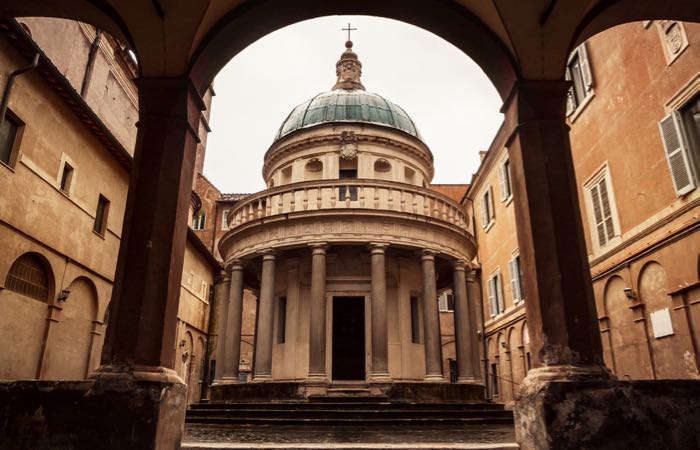
About Santorini Dave